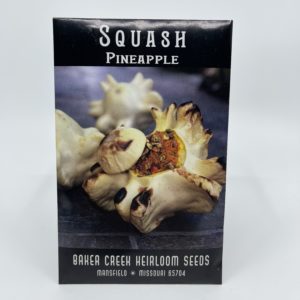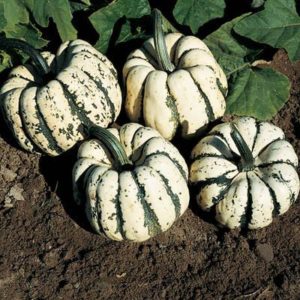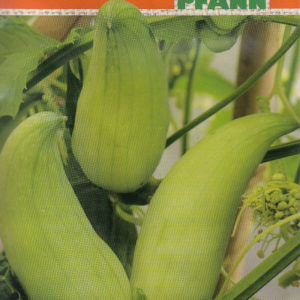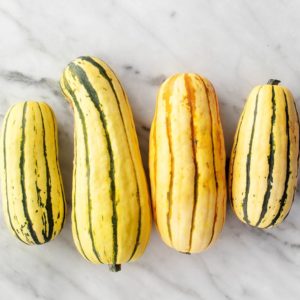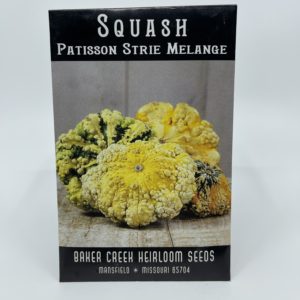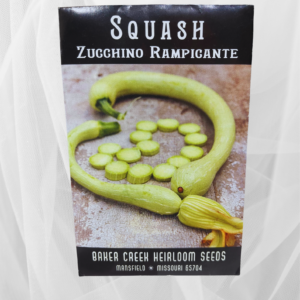قرع المهرجان
1,750 د.ك
- Truly festive coloured skins
- Great for fall decorations
- Each weighs 1-1.3kg (2-2.5lb)
- Hybrid seeds
- Matures in 85 day
C. pepo. This winter squash combines the superior sweet-flavoured flesh of a Delicata with the shape of a blocky acorn. Its festive skin has bright white and dark green markings over bright orange background stripes. Each fruit from Festival acorn squash seeds weighs 1-1.3kg (2-2.5lb), and stores for as long as three months. They are great for fall decorations, and highly ornamental. This variety produces semi-bush plants that are more compact than some of the other vine forming acorn squash types. The fruits are super delicious roasted in the oven and then chopped into soups, or served along side savoury winter vegetables during the holiday season.
Matures in 85 days. (Hybrid seeds)
Latin
Cucurbita maxima, C. pepo, & C. moschata
Family: Cucurbitaceae
Difficulty
Easy, but all squash plants take up space, and some can be huge.
Season & Zone
Season: Warm season
Exposure: Full sun
Zone: Not winter hardy. Compare the days to maturity to the length of a typical summer in your area. Days to maturity are from transplant date.
Timing
Direct sow or transplant in late May or early June once the soil is warm. For transplants, start seeds indoors during the first two weeks of May. Make sure plants are in the ground no later than June 15th. Optimal soil temperature: 25-35°C (77-95°F). Seeds should germinate in 7-14 days.
Starting
Sow seeds 2cm (1″) deep. Sow 3 seeds in each spot where you want a plant to grow, and thin to the strongest plant. Space summer squash 45-60cm (18-24″) apart in rows 90-120cm (36-48″) apart. Give winter squash and pumpkins even more room with a minimum of 90-120cm (36-48″) apart in rows 120-180cm (48-72″) apart.
Growing
Ideal pH: 6.0-6.8. These big plants need lots of food. Use 1 cup of complete organic fertilizer worked into the soil beneath each plant. All squash grow male flowers first, at later female flowers. The female flowers have tiny fruits at the base of their petals and require pollination by bees mostly. Incomplete pollination often happens at the beginning of the season, and results in misshapen fruits that are withered at the flower end. Just discard these damaged fruits before they begin to rot.. You can encourage bees to your garden by growing Phacelia or Buckwheat for improved pollination.
Harvest
Summer Squash: pick when small, if fruit gets big the plant stops producing. Check the plants regularly!
Winter Squash: Fruit is ripe if your thumbnail doesn’t mark the skin and the stem is dry and brown. Cut the stem about 4cm (2″) from the fruit. Squash survive a light frost, but store better if harvested before frost.
Storage: Field-cure for 10 days in the sun, or cure indoors in a warm room for 4 or 5 days. To prevent mould sponge the skins with a solution of 10 parts water to 1 part chlorine bleach. Store at 10-15ºC (50-60ºF) with low humidity with good air circulation. Try on a shelf in the garage.
Seed Info
In optimal conditions at least 80% of seeds will germinate. Usual seed life: 2 years. Per 100′ row: 180 seeds, per acre: 15M seeds.
Diseases & Pests
Bacterial wilt (Erwinia tracheiphila) – Remove an destroy infested plants. If striped or spotted cucumber beetles appear, control as early as possible. Powdery mildew – avoid wetting foliage if possible. Water early in the day so that above ground parts of the plants dry as quickly as possible. Avoid crowding plants and eliminate weeds around plants and garden area to improve air circulation. Viral disease – remove and destroy entire infested plant along with immediately surrounding soil and soil clinging to roots.
Companion Planting
Companions: corn, lettuce, melons, peas, and radish. Avoid planting squash near Brassicas or potatoes. Borage is said to improve the growth and flavour of squash. Marigolds and nasturtium repel numerous squash pest insects.
غير متوفر في المخزون




